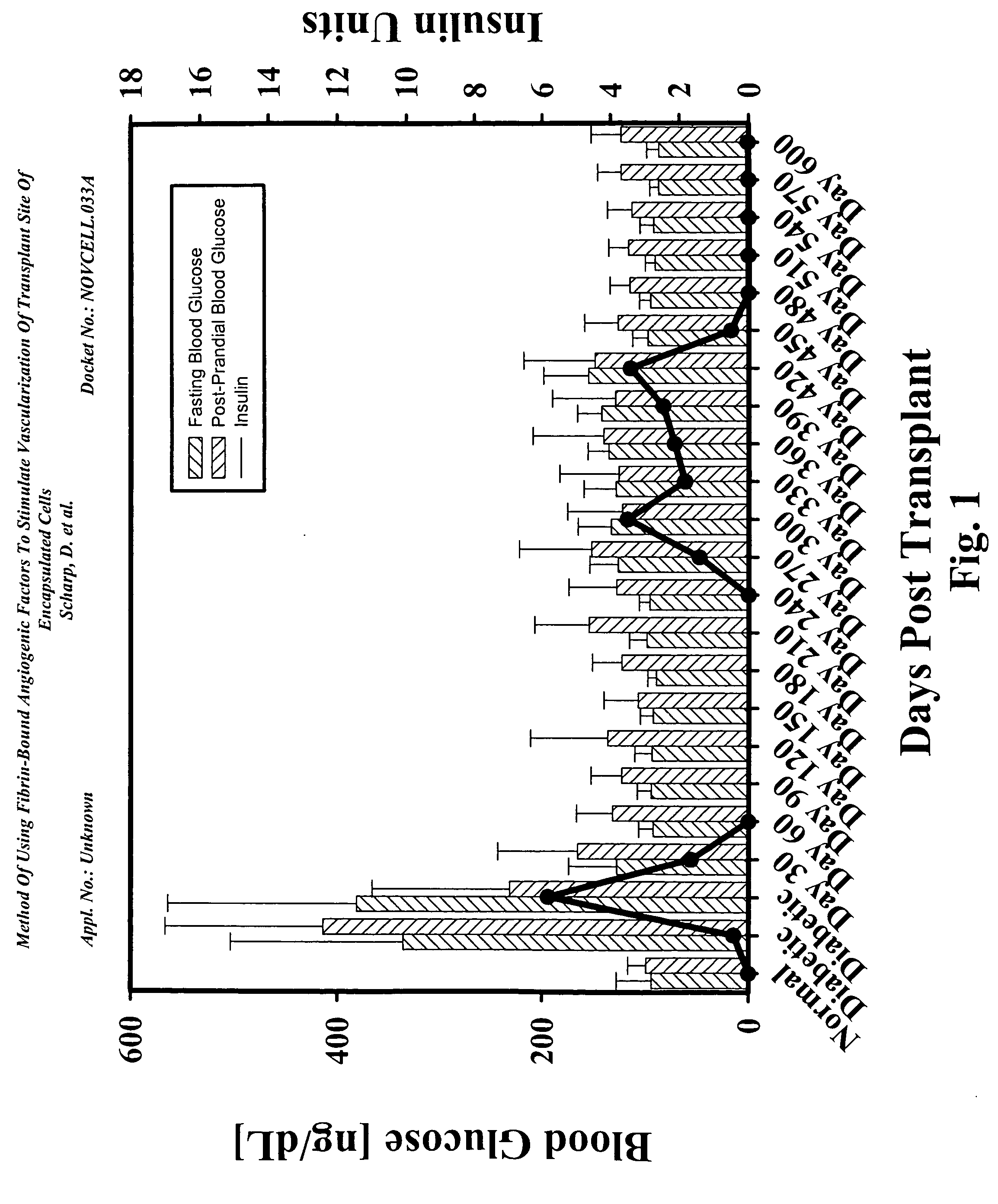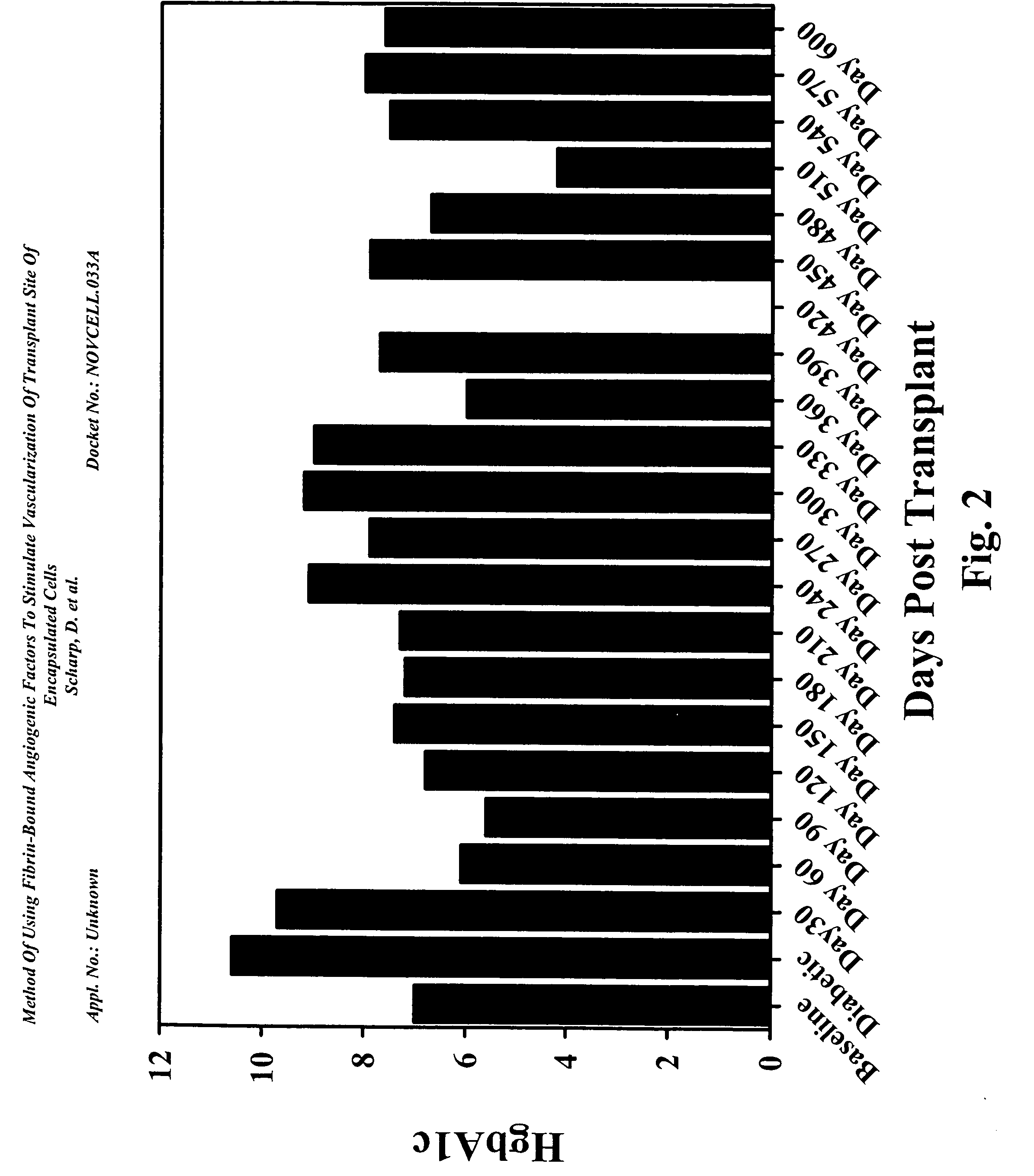Method of using fibrin-bound angiogenic factors to stimulate vascularization of transplant site of encapsulated cells
a technology of fibrin-bound angiogenic factors and vascularization of the transplant site, which is applied in the field of cell-based therapy, can solve the problems of increased portal venous pressure, portal venous thrombosis or hemorrhage, and the technique still has to overcome problems, so as to enhance the survival and function of implanted cells
- Summary
- Abstract
- Description
- Claims
- Application Information
AI Technical Summary
Benefits of technology
Problems solved by technology
Method used
Image
Examples
example 1
Subcutaneous Implant of Encapsulated Islets in Baboons
[0154] Surgical Procedures: Baboon pancreata were removed from donors, cannulated, and flushed with pancreas preservation solution and then shipped to Novocell for islet preparation and encapsulation. They were subsequently cultured, shipped to the holding facility for implantation, and then prepared for surgical implantation by suspension in culture medium, using similar protocols as are proposed for human islet preparation. The baboons were anesthetized, and a 16-gauge catheter was placed into the subcutaneous site of the anterior abdomen. A trochar was inserted through the implanted catheter to create a “fan shaped” area of 1-10 subcutaneous tracts (˜1″-5″ each in length) under the skin of the abdomen. The test material (in 1 to 10 ml volume) was gently suspended, pulled into a syringe, and deposited along the subcutaneous tracts (or “pockets”) with an even pattern of deposition throughout the pockets. The needle insertion s...
example 2
Encapsulated Islet Allograft without VEGF in Streptozotocin Diabetic Baboons
[0158]FIG. 1 shows the results of a diabetic baboon implanted with encapsulated islet allografts. This diabetic baboon recipient showed the ability to achieve insulin independence within 17 days after subcutaneous implantation of encapsulated islet allografts. This was in contrast to Cynomolgus primate diabetics where insulin independence was only achieved 30 days after islet implantation.
[0159] The baboon diabetic model used IM injection of cyclosporine for administration of the drug to these large animals. This eliminated the variances in the 24-hour trough levels. FIG. 2 shows this recipient achieved normal Hemoglobin A1c levels by 60 days post-implant and remained in the normal level through 210 days without insulin. There were slight increases followed by decrease between day 210 and day 360. The animal returned to partial graft function at day 240 requiring low doses of insulin.
[0160] At day 420, t...
example 3
Subcutaneous Site Enhancement by Implanting Encapsulated Islet Allografts within Fibrin Glue Conjugated with VEGF
[0170] There was a continual finding of new blood vessel formation surrounding the PEG encapsulated islets in the subcutaneous site several weeks following implant. The subcutaneous site was enhanced by an angiogenic growth factor at the time of implant to increase the survival of the encapsulated islets during the first few weeks post-implant. This approach reduced the number of isolated islets required to eliminate diabetes.
[0171] A new angiogenic reagent has been developed that is used for wound healing. A human fibrin glue product is used as a base for adding VEGF. The conjugated VEGF breaks down at the same time as the fibrin clot breaks down in the body. A slow release of VEGF at the site causes the development of normal capillaries.
[0172] These results were confirmed by transplanting empty PEG beads, as well as, PEG conformally coated islets in diabetic mice an...
PUM
| Property | Measurement | Unit |
|---|---|---|
| Time | aaaaa | aaaaa |
| Time | aaaaa | aaaaa |
| Biological properties | aaaaa | aaaaa |
Abstract
Description
Claims
Application Information
 Login to View More
Login to View More - R&D
- Intellectual Property
- Life Sciences
- Materials
- Tech Scout
- Unparalleled Data Quality
- Higher Quality Content
- 60% Fewer Hallucinations
Browse by: Latest US Patents, China's latest patents, Technical Efficacy Thesaurus, Application Domain, Technology Topic, Popular Technical Reports.
© 2025 PatSnap. All rights reserved.Legal|Privacy policy|Modern Slavery Act Transparency Statement|Sitemap|About US| Contact US: help@patsnap.com



